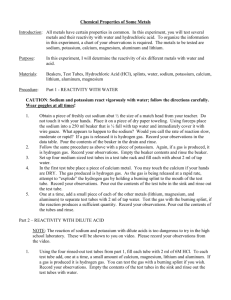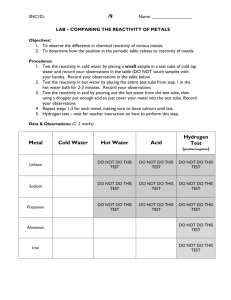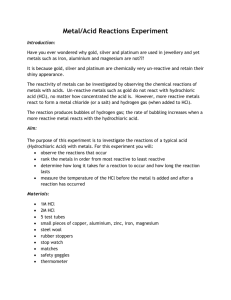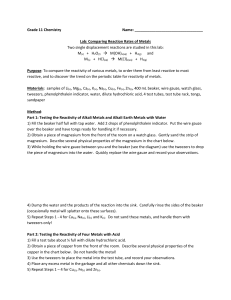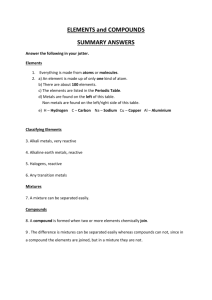REACTIVITY OF THE ELEMENTS IN THE PERIODIC TABLE
advertisement
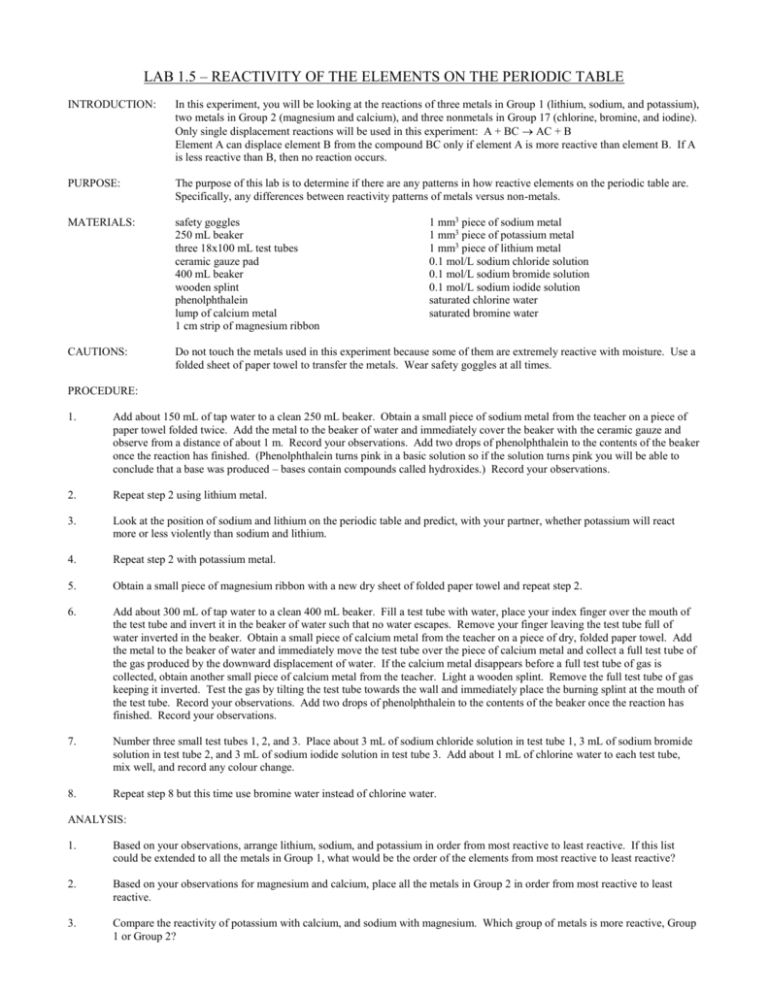
LAB 1.5 – REACTIVITY OF THE ELEMENTS ON THE PERIODIC TABLE INTRODUCTION: In this experiment, you will be looking at the reactions of three metals in Group 1 (lithium, sodium, and potassium), two metals in Group 2 (magnesium and calcium), and three nonmetals in Group 17 (chlorine, bromine, and iodine). Only single displacement reactions will be used in this experiment: A + BC AC + B Element A can displace element B from the compound BC only if element A is more reactive than element B. If A is less reactive than B, then no reaction occurs. PURPOSE: The purpose of this lab is to determine if there are any patterns in how reactive elements on the periodic table are. Specifically, any differences between reactivity patterns of metals versus non-metals. MATERIALS: safety goggles 250 mL beaker three 18x100 mL test tubes ceramic gauze pad 400 mL beaker wooden splint phenolphthalein lump of calcium metal 1 cm strip of magnesium ribbon CAUTIONS: Do not touch the metals used in this experiment because some of them are extremely reactive with moisture. Use a folded sheet of paper towel to transfer the metals. Wear safety goggles at all times. 1 mm3 piece of sodium metal 1 mm3 piece of potassium metal 1 mm3 piece of lithium metal 0.1 mol/L sodium chloride solution 0.1 mol/L sodium bromide solution 0.1 mol/L sodium iodide solution saturated chlorine water saturated bromine water PROCEDURE: 1. Add about 150 mL of tap water to a clean 250 mL beaker. Obtain a small piece of sodium metal from the teacher on a piece of paper towel folded twice. Add the metal to the beaker of water and immediately cover the beaker with the ceramic gauze and observe from a distance of about 1 m. Record your observations. Add two drops of phenolphthalein to the contents of the beaker once the reaction has finished. (Phenolphthalein turns pink in a basic solution so if the solution turns pink you will be able to conclude that a base was produced – bases contain compounds called hydroxides.) Record your observations. 2. Repeat step 2 using lithium metal. 3. Look at the position of sodium and lithium on the periodic table and predict, with your partner, whether potassium will react more or less violently than sodium and lithium. 4. Repeat step 2 with potassium metal. 5. Obtain a small piece of magnesium ribbon with a new dry sheet of folded paper towel and repeat step 2. 6. Add about 300 mL of tap water to a clean 400 mL beaker. Fill a test tube with water, place your index finger over the mouth of the test tube and invert it in the beaker of water such that no water escapes. Remove your finger leaving the test tube full of water inverted in the beaker. Obtain a small piece of calcium metal from the teacher on a piece of dry, folded paper towel. Add the metal to the beaker of water and immediately move the test tube over the piece of calcium metal and collect a full test tube of the gas produced by the downward displacement of water. If the calcium metal disappears before a full test tube of gas is collected, obtain another small piece of calcium metal from the teacher. Light a wooden splint. Remove the full test tube of gas keeping it inverted. Test the gas by tilting the test tube towards the wall and immediately place the burning splint at the mouth of the test tube. Record your observations. Add two drops of phenolphthalein to the contents of the beaker once the reaction has finished. Record your observations. 7. Number three small test tubes 1, 2, and 3. Place about 3 mL of sodium chloride solution in test tube 1, 3 mL of sodium bromide solution in test tube 2, and 3 mL of sodium iodide solution in test tube 3. Add about 1 mL of chlorine water to each test tube, mix well, and record any colour change. 8. Repeat step 8 but this time use bromine water instead of chlorine water. ANALYSIS: 1. Based on your observations, arrange lithium, sodium, and potassium in order from most reactive to least reactive. If this list could be extended to all the metals in Group 1, what would be the order of the elements from most reactive to least reactive? 2. Based on your observations for magnesium and calcium, place all the metals in Group 2 in order from most reactive to least reactive. 3. Compare the reactivity of potassium with calcium, and sodium with magnesium. Which group of metals is more reactive, Group 1 or Group 2? 4. Which do you think is the most reactive metal in the periodic table? Explain your answer. 5. In a single displacement reaction, the single element can “kick out” the element in the compound only if the single element is more reactive than the element in the compound. Otherwise, there is no reaction. Use this information and your result from question 7 to list the three nonmetals, iodine, bromine, and chlorine, in order from most reactive to least reactive. If this list could be extended to all the nonmetals in Group 17, what would be the order of the elements from most reactive to least reactive? 6. Is the order of reactivity for the nonmetals the same as that for the metals? 7. Based on your answer to question 9 and knowing how the metals in Group 1 and Group 2 behave, predict which group of nonmetals would be more reactive, Group 6 or Group 7. 8. Which do you think is the most reactive nonmetal in the periodic table? (Remember that the elements in Group 18, the noble gases, are generally nonreactive.) 9. Draw an outline of the periodic table. On your diagram indicate where the noble gases are located. Show the dividing line between the metals and nonmetals. Summarize your findings from this experiment by labeling the diagram with the following terms: (a) metals (b) nonmetals (c) the general direction, both horizontal and vertical, in which metals become more reactive (d) the general direction, both horizontal and vertical, in which nonmetals become more reactive 10. Based only on the results from this experiment, select the more reactive element from each pair of elements below: (a) Li or Be (f) Rb or Ca (b) Zn or Al (g) Pt or Au (c) F or S (h) Pb or Sn (d) He or F (i) Sr or Sc (e) C or Si (j) As or Se OBSERVATIONS: Table 1: Reaction of Group 1 and 2 Metals with Water Group Metal Reaction with water Phenolphthalein Test sodium 1 lithium potassium magnesium 2 calcium RESULT OF BURNING SPLINT TEST DONE ON GAS COLLECTED FROM REACTION OF CALCIUM WITH WATER: Table 2: Displacement Reaction of Non-Metals sodium chloride chlorine bromine sodium bromide sodium iodide



